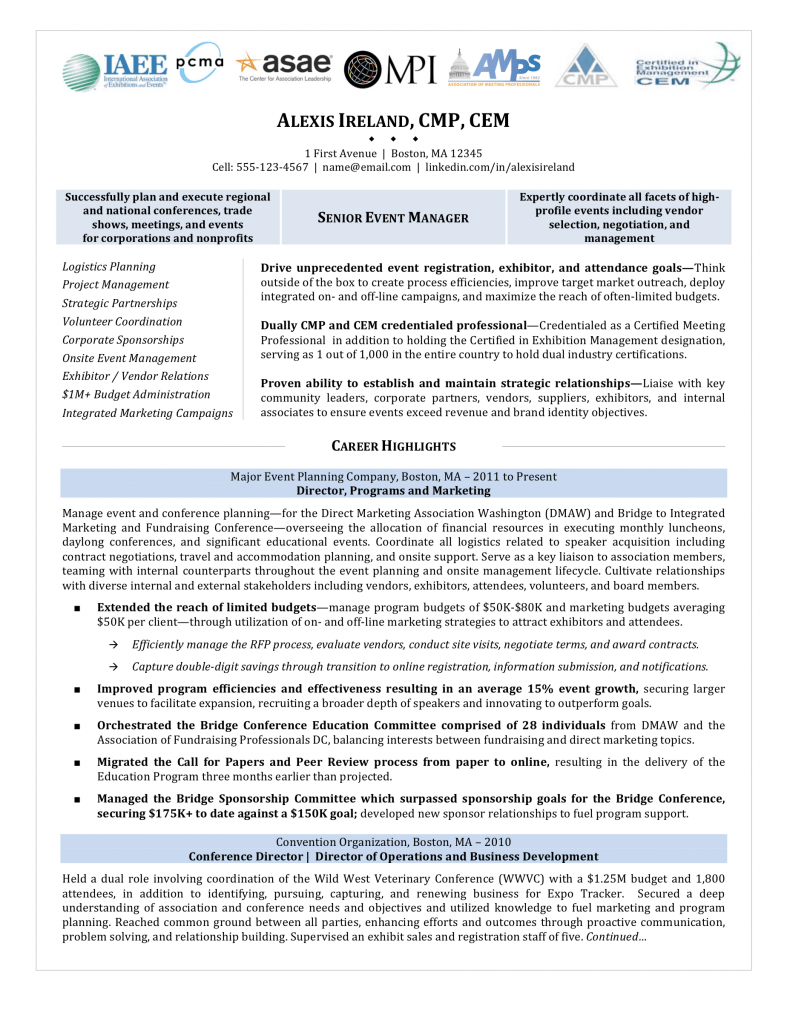Meet Alexis!
Alexis has been a client of mine for several years, first coming to me when she wanted to transition into the field of event planning. From her first résumé to her current need for an updated résumé, her career had skyrocketed from someone supporting event planning functions to an executive-level leader. Alexis now works with major event planning organizations to coordinate every facet of national conferences. She contacted me recently to ensure her résumé reflected the level of involvement she now holds in the industry.
Why did Alexis need help?
Given it had been a few years since Alexis and I had updated her résumé, she provided me with her own version of an updated résumé, one filled with bullet point after bullet point of responsibilities and contributions. Her attempt at updating her résumé left her with a four-page document with very little prioritization of information, no aesthetic appeal, and perhaps most important, a document that did little to position her for the next level in her industry.
The “makeover!”
From her self-attempted four-page résumé update, I turned Alexis’ résumé into a three-page, executive-level overview of the past 12 years of her career. With page three solely listing education, affiliations, and presentations, her résumé was essentially two pages of content reflective of the contributions she had made during her related professional engagements.
To open Alexis’ updated résumé, I started with a graphical representation of her credentials and industry involvement, quite an impressive at-a-glance strategy that would be sure to differentiate her résumé from those of her competitors. By sourcing logos online—ensuring they were presented to “float” on the page—this element added interest and served as a reader engagement tool.
Next, in the qualifications summary, I immediately positioned Alexis as how she wanted to be seen: a Senior Event Manager. To the left and right of this professional title, I presented her key qualifiers based on her proven track record in the field. From the heading of the summary, I flowed into three statements which further introduced her candidacy and validated claims through examples of Alexis’ experiences. Lastly, to the left of these statements, I listed related core skills—again, serving as an at-a-glance reminder of how Alexis was qualified for the jobs to which she was going to be applying.
I turned Alexis’ most recent work experience—described by her in 470 words and 17 bullet points—into a much more succinct 260-word presentation of her responsibilities and accomplishments. Differentiating content based on priority, Alexis’ “job” was presented in a paragraph format in order to provide the necessary context for her contributions. Given accomplishments are the most important component of any candidate’s professional experience section, I focused on presenting well-rounded contributions in bullet point form, narrowing down Alexis’ 17 bullet points to five well-constructed points. In this section, I was sure not only to present the results of Alexis’ efforts, but also some of the key actions taken to achieve the results, ensuring prospective employers were provided with appropriate validation of her abilities.
What did Alexis think?
I received such nice comments from Alexis once she reviewed her updated résumé: “WOW! I love my new résumé. My résumé is a work of art and one that will open many doors in my field of conference/trade show management. Thank you!”
Creating your “makeover”…
When presenting your candidacy on paper, be sure you are (1) targeting your content to sell yourself as how you want to be seen, (2) ensuring aesthetic appeal and reader engagement, (3) prioritizing content to facilitate ease of readability, (4) differentiating responsibilities from accomplishments, and (5) ensuring focus on the latter. If you follow these steps, you will emerge with a stronger presentation of your candidacy and the ability to conduct a more effective search.
NEW RESUME





